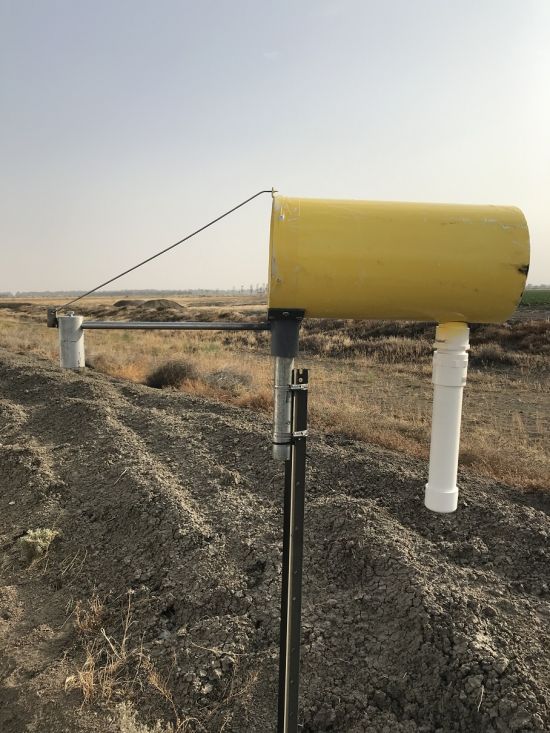Passive insect traps may provide a cost effective and quick method to identify insects and the absence or presence of virus in vectors.
AuSPICA and Australian Processing Tomato Research Council (APTRC), with funding support from the Horticulture Innovation Funds, has established a passive insect surveillance trapping network across the processing tomato and seed potato production regions, consisting of a total of forty traps, split equally between the processing tomato industry and seed potato industry.1
Processing tomato and seed potato growers in Victoria constantly experience pressure from a range of insect vectors. Processing tomato growers in the past have experienced complete crop failure as a result of thrips and aphids entering crops at transplanting and transmitting virus. Currently growers use large quantities of insecticides to control such pests. With a quick and cost effective way to identify insect pests and the presence or absence of virus in insect populations then they may be able to reduce the number of insecticide applications during the season, thus reducing input costs, while at the same time preventing crop failure.
Sticky traps are an expensive and time-consuming method of collecting insect samples from crops. As a result they are not widely used and are only currently used for monitoring for exotic pests for area freedom. This passive insect trap technology to enable detection of insects is currently being developed. This activity aimed to facilitate the establishment of a passive surveillance trapping network across the processing tomato and seed potato industry which could then be utilised in the development and adoption of the diagnostic capability by AgriBioscience, Victoria.
Presentation: Establishment of a passive insect surveillance trapping system. This PDF opens in a new window (Note: this document does not meet WCAG 2.0 accessibility guidelines) or Download PowerPoint Presentation: Establishment of a passive insect surveillance trapping system
Forty passive surveillance traps based on the Yellow Macquarie Island Traps were constructed, and installed based on four per property, with each trap being placed on a different side of the crop to ensure that any pests entering the crop from the north, south, east or west are detected. The forty traps were equally split between the processing tomato and seed potato properties.
The initial plan was to have four traps per 80-100ha block, with smaller blocks (<20ha) in the future possibly containing two traps. The actual location of the traps within the field does depend upon what insects are to be monitored, i.e. are insects within the crop or are they potential incursions coming in from the edges of the crop.
Balancing the aim of the trapping with the requirements of ongoing maintenance of the crop means that the best location for the traps was at the edges/ corners of the paddock - i.e. out of the crop was more suitable. This minimised the chance of them getting damaged during the season, or the need for them to be removed each time the crop was sprayed etc.
1 At the time of this project was carried out, high throughput DNA technology was not commercially available in Victoria, however discussions are currently underway with labs in South Australia and overseas.
 passive surveillance trap
passive surveillance trap
How to Install Traps in the Field
Number of traps per paddock
Regarding number of traps- depends on the level of certainty you want to catch rare species. There is maths behind this i.e. pr= (1-(1-pr(detecting) to the power number of visits). But you have to specify what level of detection you want for given prevalence of the pest. There is no short answer or solution to this, apart from, more traps is better!
Initial plan was to have 4 traps per 80-100ha block, with smaller blocks (<20ha) perhaps 2 are sufficient?
Location of traps
Partly depends upon the aim, if you want to monitor a population to determine potential spraying times, economic threshold - then amid the crop is better.
However, if you want to monitor for new incursions, migration/ dispersal events then edges of the crop is also suitable.
Balancing the aim of the trapping with the requirements of ongoing maintenance of the crop - probably means that the edges/ corners of the paddock - i.e. out of the crop is more suitable for your needs.
A possible way to install them would be on the edge of the paddock (on the edge of the last row of the crop), perhaps near the corners, with 4 per crop. Best to ensure they will be out of the way of the sprayer and cultivator etc. This will minimise the chance of them getting damaged during the season, or the need for them to be removed each time the crop is sprayed etc.
Liquid used in container
The preservation solution used in the past is 40% propylene glycol, which preserves both the insects and their DNA. You may need to purchase 100% propylene glycol and dilute to 40%.
Collection of samples for analysis
This HIF project proposal stated that a subset of the trap samples collected by the Industry would be assessed. Ten traps (5 from the processing tomato and 5 seed potatoes) (4 traps from the field to be combined as 1 sample) per season (n=40/year), to determine which insects are present in traps (identified to order level), to validate that the surveillance trapping system is collecting appropriate insects. The samples collected through this project will be archived by Agriculture Victoria for future DNA analyses with the aim to detect specific target pests (e.g. aphids) and pathogens (e.g. viruses) through high throughput DNA assays, that are currently being developed through associated Agriculture Victoria R&D projects.
Additional samples may be collected by the industry and also utilised to determine the presence or absence or various insects. Samples may also be sent to other laboratories either interstate or overseas. The cost of this is outside the initial project.